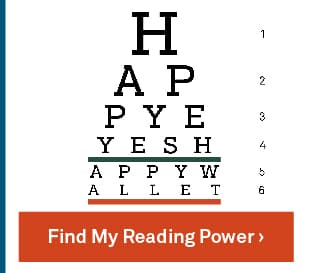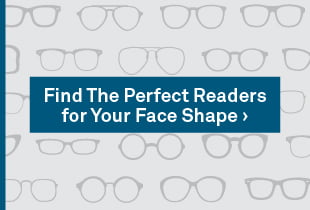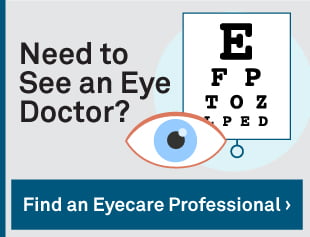Author: Sam Calderon
Reviewed by Thomas Stokkermans, OD, PhD on 11/20/2023
Is It Safe to Wear Reading Glasses While Driving?
Do you need reading glasses for reading the newspaper or using your smartphone? Non-prescription readers often help people with presbyopia, an age-related condition that makes it difficult to see objects up close. But is it safe to wear them when behind the wheel?
No, it’s not considered safe to wear reading glasses while driving. Though they can help you see clearly up close, they’re not designed for distance vision. Wearing reading glasses while driving could blur your vision and compromise your ability to judge distances accurately.
If you’re having trouble seeing objects far away, you may need prescription lenses from an eye doctor. An optometrist can help determine the appropriate strength for your vision needs.
What Are Reading Glasses?
Reading glasses (sometimes called “readers”) help you with focusing so it’s easier to see objects up close. They’re available over the counter at most drugstores and retail shops. You can also purchase them online without a prescription.
Non-prescription readers come in a variety of strengths. While higher-strength readers aren’t available without a prescription in some states, they usually range from around +1.00 to +4.00 diopters (D). “Diopter” refers to the power of the lens. The higher the number, the stronger the magnification.
Who Should Wear Reading Glasses?
Non-prescription reading glasses are typically worn by people with presbyopia, a common age-related vision problem. As we get older, our eyes lose the ability to focus on nearby objects, meaning it’s harder to see things like text or small print. Common symptoms of presbyopia include blurry vision, eye strain, and headaches. This can make it challenging to perform everyday tasks at home or work.
While some people only wear readers occasionally, others rely on them frequently for activities like reading, knitting, or using their smartphones. They’re an effective solution for people who struggle with up-close vision.
Can You Use Reading Glasses While Driving?
Reading glasses are not intended for distance vision and should not be worn while driving. In fact, wearing them while driving can be dangerous. Readers make it difficult to see objects at a distance, which can increase your risk of accidents on the road.
Driving requires clear vision at all times. Missing important details like road signs, traffic signals, or potential hazards can lead to serious consequences. That’s one of the reasons it’s important to wear the proper eyewear for driving.
What Should You Do If You Need Glasses for Driving?
If you’re having trouble seeing while driving, the first step is to schedule an appointment with your eye doctor. They can perform an eye exam to determine if you need prescription lenses. Prescription eyewear can correct refractive errors, like nearsightedness, farsightedness, and astigmatism, and provide you with the clearest possible vision.
What If You Have More Than One Vision Problem?
Readers.com offers bifocal lenses with your preferred reading strength at the bottom portion of the lens, while the top portion is clear. This helps you achieve clear vision when performing near work without interfering with your mid- and far-distance vision. Most often, these bifocal-style readers don’t require a prescription.
However, some people need correction for both distance and up-close vision. In these cases, prescription multifocal lenses may be recommended. These types of lenses have two or more powers built into a single lens. Prescription lens options for vision correction include:
- Bifocals – Bifocals have two separate prescription strengths, one for distance and one for near vision. The lens is divided into two sections and has a visible line where the different strengths meet.
- Trifocals – Trifocals have three separate prescription strengths: one for distance, one for intermediate vision, and one for near vision. They also have visible lines dividing each section of the lens.
- Progressive lenses – Progressives are popular because they can provide clear eyesight at all distances without visible lines. They gradually change in power from the top of the lens to the bottom, allowing for a more seamless experience and appearance.
Drive Safely With the Right Eyewear
The wrong type of eyewear can jeopardize your safety on the road. If you’re experiencing distorted or blurry vision while driving, with or without prescription lenses, don’t ignore these warning signs. Schedule an appointment with your eye doctor to find the best solution for your vision and eye health.
Readers.com is a proud provider of non-prescription reading glasses in a wide variety of styles and strengths. Shop our selection today to find the perfect pair for reading and other close-up activities.
SOURCES
- Common age-related eye problems. Cleveland Clinic. November 2020.
- Non-prescription ‘cheaters’ vs. prescription glasses. Cleveland Clinic. February 2022.
- Presbyopia. American Optometric Association. Accessed November 2023.
- Eyeglasses: The basics. All About Vision. February 2019.*
The sources listed here have been provided for informational purposes only. The citation of a particular source does not constitute an endorsement or approval of EssilorLuxottica products, services, or opinions by such source.
*Like Readers.com, All About Vision and AAV Media, LLC are affiliates of EssilorLuxottica.





0 Comments